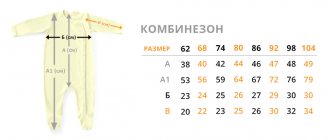The first information we receive about a newborn child is gender, weight, height, and general condition. It is this information that we willingly share with relatives, friends and acquaintances when we announce the arrival of a long-awaited baby in the family. And this is not surprising, because height and weight are the first achievements of a baby, as well as indicators of his health. To assess these indicators, tables of norms for height, weight, and body mass index (BMI) are used.
Weight standards
Newborn weight standards
| Weight, kg | Less than average | Average weight, kg | Above average |
| boy | 2,5 – 2,8 | 2,9 – 3,9 | 4,0 – 4,4 |
| girl | 2,4 – 2,7 | 2,8 – 3,7 | 3,8 – 4,2 |
The weight ranges shown in the table (less than average, average, more than average) are the norm. However, it may turn out that a child in the “above average” category may be overweight; this can be clarified by analyzing the body mass index in the norm calculator.
Growth norms
Norms of body length (height) of newborns
| Body length, cm | Below the average | Average height, cm | Above average |
| boy | 46,1 – 47,9 | 48,0 – 51,8 | 51,9 – 53,7 |
| girl | 45,4 – 47,2 | 47,3 – 51,0 | 51,1 – 52,9 |
All body length ranges indicated in this table are considered normal. Moreover, the height of boys up to 55.6 cm, and girls up to 54.7 cm is also not considered a deviation, especially if there are hereditary prerequisites.
Simply assessing a newborn's weight and height is incomplete. The most accurate idea of the nature of a child’s weight is provided by an analysis using the body mass index, which can be performed in our calculator for children.
About deviations from the norms
If the height, weight or BMI of the baby at birth does not fit within the specified norms, then the doctor must find and analyze the reasons in order to exclude diseases that affect growth and development. Most often, short stature or very high height and weight are simply hereditary, in this case there is no reason to worry.
Also, deviations in the height, weight and health of newborns can be caused by heredity, the state of health of the mother during pregnancy, or her lifestyle during this period (excessive or low physical activity, insufficient or excess nutrition, smoking, alcohol).
Healthy babies born outside the norm, as a rule, compensate for the lack or excess weight within several months of life, subject to proper care and proper feeding.
See also reasons for deviations and what to do about them.
Newborn weight gain and growth
First week - weight loss and first gains
The weight of newborn babies is very unstable in the first week and may decrease - this is a manifestation of a healthy norm.
In the first days of life, the young body intensively rids itself of excess fluid. For this reason, the baby can lose up to 7-10% of its original weight. For example, with an initial weight of 3500 g, a child can lose weight by almost 350 grams (up to 3150 g) in 3-4 days.
As a rule, such a drop in weight is clearly visible during natural breastfeeding, because the mother’s production of breast milk usually begins only 2-4 days after birth. Until then, the child eats only colostrum, which is produced by the mammary glands only in small quantities, which cannot have any effect on weight.
If the child is kept on artificial or mixed feeding, then the initial weight loss will be insignificant or will not appear at all.
Infant weight gain in the first week
| Gain, g | Average | Minimum |
| boy | 150 ±150 | -200 … -300 |
| girl | 100 ±100 | -150 … -250 |
* Gain is calculated from the initial weight with which the child was born
So, in the first week of life, boys gain an average of 150 grams, girls - 100 g. However, a significant percentage of children (about 25%) may show zero or negative gain (weight loss), and this is also normal for them. There will be enough time in the following weeks to compensate for the initial weight loss. But, in this case, the baby’s weight must be regularly monitored: after the first week, the weight must increase steadily, otherwise it is necessary to look for and solve a problem with feeding or health with the help of a doctor.
If on any day of the first week it turns out that the baby has lost more than 7% of its original weight, it is recommended to consult a specialist. If you have lost more than 10%, medical intervention is mandatory.
Gain and gain in the first month
The following table shows the approximate norms of weight gain and growth of infants in the first month of life (30-31 days).
So, it is advisable for a boy to gain 0.77–1.45 kg, for a girl 0.67–1.27 kg. Norms of newborn weight gain in the first month
| Weight gain, kg | Short | Average | Big |
| boy | 0,38 – 0,76 | 0,77 – 1,45 | 1,46 – 1,76 |
| girl | 0,40 – 0,66 | 0,67 – 1,27 | 1,28 – 1,58 |
* The table shows weight gain from birth to 30-31 days from birth
Low and high weight gain usually indicate that the feeding intensity can be increased or decreased accordingly. If the baby’s weight gain goes beyond the proposed ranges, then this is a reason for the local pediatrician to intervene. He must find the cause of too low or excessive weight gain (incorrect feeding, temporary illness of the child or mother, etc.). Then, depending on the child’s current growth and health indicators, the doctor develops feeding recommendations so that all indicators gradually return to normal.
Please note that many doctors, in the old-fashioned way, count weight gain from the minimum, they are more used to it this way. However, in modern weight gain standards, the count is based on the initial weight with which the child was born, since this makes it possible to evaluate gains more objectively. Therefore, the norms for weight gain in the first week and first month indicated on this website measure weight gain from the initial weight at birth.
Growth in the first month for boys is 3.5 - 6.0 cm, for girls 3 - 5.5 cm.
Apgar score
The newborn's condition is assessed using the Apgar scale at 1 and 5 minutes of life. Typically, a low score at 1 minute identifies neonates requiring resuscitation; and the score at 5 minutes indicates the effectiveness of these measures.
Most newborns in the 1st minute of life have an Apgar score of 7-8 points (mild acrocyanosis is observed due to transitional circulation and decreased muscle tone). A score of 4-6 points indicates moderate asphyxia, 0-3 points indicates severe asphyxia. Only 15% of newborns have a score of 10 points in the 1st minute of life.
At the 5th minute of life, the Apgar score usually rises to 8-10 points. If the Apgar score is less than 7 at 5 minutes, the newborn is assessed additionally every 5 minutes for 20 minutes.
To stimulate the activity of the newborn, gently rub his torso, back, limbs and lightly pat his soles. Other methods of stimulation are not acceptable due to the risk of injury to the newborn.
In case of severe asphyxia (0-4 points on the Apgar scale), repeated suction of mucus and artificial ventilation of the lungs with 100% oxygen are performed. If aspiration of amniotic fluid is suspected, immediately after the birth of the head (before the birth of the body!), carefully suction out the contents of the pharynx and trachea, perform tracheal intubation and oxygenation with positive pressure oxygen (100% oxygen).
The primary toilet of a newborn consists of treating the eyes with a 30% solution of sodium sulfacyl (prevention of ophthalmoblenorrhea). A clamp is applied at a distance of 0.5-0.8 cm from the umbilical ring, the umbilical cord stump is treated with a 5% iodine solution and a gauze bandage is applied. Primary treatment of a newborn's skin consists of removing curdled oil, blood residues, meconium, mucus with a cotton swab, and irrigating with sterile oil. After finishing the primary toilet of the newborn, his height from head to toe, body weight, head circumference (according to the straight diameter) and shoulder circumference are measured. Bracelets are placed on the arms indicating the mother's last name, the gender of the child, the birth history number, and the date and time of birth.
Newborn Apgar score
| Options | Rating, points | ||
| 0 | 1 | 2 | |
| Heartbeat | Missing | Up to 100 beats/min | More than 100 beats/min |
| Breathing, screaming | Missing | Brady, arrhythmic breathing, weak cry | Breathing is normal, loud scream |
| Muscle tone | The tone is weak, the limbs are flaccid, drooping | The tone is reduced, the limbs are slightly bent | Active movements |
| Reflexes (reaction to suction, irritation of soles) | not defined | grimace | Coughing, sneezing, crying |
| Skin tone | Generalized pallor or cyanosis | Pink body, blue limbs | Pink |
In case of prematurity, the degree of respiratory disorders is additionally assessed using the Silverman-Andersen scale every 6 hours after birth for 1-2 days or until respiratory disorders are eliminated.
A full-term newborn has a gestational age of > 37 weeks, body weight is usually > 2500 g, height (from crown to toe) > 45 cm and averages 3500 ± 500 g and 50 ± 5 cm, respectively. The height of the head is 1/4 of the body length of the newborn ; head circumference 34-36 cm, chest circumference - 32-34 cm. A full-term newborn screams loudly, has active movements, pronounced muscle tone and a sebaceous reflex.
The skin is pink, elastic, covered with vellus hair (mainly on the shoulder girdle), the subcutaneous layer is well developed. The auricles and nasal cartilage are elastic, the nails are hard and extend beyond the edge of the nail bed. The navel is located midway between the pubic symphysis and the xiphoid process. In boys, the testicles are lowered into the scrotum; in girls, the labia minora are covered by the labia majora.
Control of weight gain and feeding intensity
In Russia, infants are first brought to a routine examination by a pediatrician at the age of 1 month. And during control weighing, a deviation of weight or BMI from the norm is often detected, which could have been avoided if weighing and control were carried out weekly.
For example, a young mother breastfeeds her baby “on demand,” as is widely recommended. However, if the baby is calm, then he rarely “gives voice”, so an inexperienced mother does not feed him as often as is actually necessary. As a result, the child gains weight very slowly, and at the end of the month, a deficiency in body weight .
The opposite situation is also possible, for example, when a child is fed formula in unlimited quantities, especially under the “sensitive guidance” of the older generation. In such conditions, the baby rapidly gains weight, becoming overweight or obese.
The relevance of this problem is due to the fact that from birth a child begins to form his own eating habits, which will subsequently be difficult to change. As a result, a predisposition to underweight or obesity can last a lifetime.
To avoid such situations in the first month of life, it is recommended to weigh the child weekly (at ages 7, 14, 21 and 28 days), calculate weight gain over the past week and compare it with reference ranges for weekly weight gain.
Weighing can be done at home using a suitable scale with an accuracy of at least 0.1 kg, preferably 0.01 kg. Reference weekly weight gain of newborns, in grams
| Period | Boy | Girl |
| 1 Week | 150 ± 150 | 100 ± 100 |
| 2 week | 250 ± 100 | 200 ± 100 |
| 3 week | 320 ± 80 | 270 ± 70 |
| 4 week | 320 ± 80 | 270 ± 70 |
*See also the continuation of the table up to 6 months
If the actual weekly weight gain turns out to be more or less than the reference range, then this makes it clear in which direction the child’s feeding intensity should be adjusted: towards an increase or a moderate decrease.
For example, if a boy gained 50 grams in the second week (from 7 to 14 days), then the intensity of feeding should be increased slightly. If a girl gained 500 grams in the 3rd week, then the intensity of feeding can be reduced slightly.
Please note that children's actual weekly gains may differ significantly from the reference ones and are often negative, especially in the first week - this is normal.
Table - Height of girls aged 11 to 17 years
| Age | Very low (in cm) | Low (in cm) | Average (norm) (in cm) | Above average (in cm) | High (in cm) | Very high (in cm) |
| 11 years | 131.8 to 136.2 | 136.2 to 140.2 | 140.2 to 148.8 | 148.8 to 153.2 | 153.2 to 157.7 | more than 157.7 |
| 12 years | 137.6 to 142.2 | 142.2 to 145.9 | 145.9 to 154.2 | 154.2 to 159.2 | 159.2 to 163.2 | more than 163.2 |
| 13 years | 143.0 to 148.3 | 148.3 to 151.8 | 151.8 to 159.8 | 159.8 to 163.7 | 163.7 to 168.0 | more than 168.0 |
| 14 years | 147.8 to 152.6 | 152.6 to 155.4 | 155.4 to 163.6 | 163.6 to 167.2 | 167.2 to 171.2 | more than 171.2 |
| At the age of 15 | 150.7 to 154.4 | 154.4 to 157.2 | 157.2 to 166.0 | 166.0 to 169.2 | 169.2 to 173.4 | more than 173.4 |
| 16 years | 147.8 to 152.6 | 155.2 to 158.0 | 158.0 to 166.8 | 166.8 to 170.2 | 170.2 to 173.8 | more than 173.8 |
| 17 years | 152.2 to 155.8 | 155.8 to 158.6 | 158.6 to 169.2 | 169.2 to 170.4 | 170.4 to 174.2 | more than 174.2 |
Breastfeeding
Newborn babies need breast milk. Therefore, a first-time mother, while still in the maternity hospital, must make every effort to stimulate milk production. It is painful, debilitating, but very important for the health of both this baby and subsequent children.
Accordingly, while the mother does not have milk, the baby should still be fed from the breast with colostrum, which is produced in small quantities by the mammary glands during this period. Colostrum is many times more nutritious than milk and contains many beneficial substances that provide the child with passive immune protection, activate the digestive system, and stimulate growth and development.
If the baby does not have enough colostrum, then until milk appears, he can be fed with an artificial formula, and only nipples with a minimum flow (minimum hole) should be used, otherwise the child may subsequently refuse the breast.
If the newborn is not put to the breast and is deprived of colostrum and breast milk, then the child is deprived of the enormous benefits received from natural feeding. Therefore, when feeding only artificial formulas, infants often experience weakened immunity, digestive problems (constipation, colic) become more acute, and a relatively weak psycho-emotional connection with the mother is formed. In addition, formula feeding is very expensive and constitutes a significant portion of the expenses for most Russian families.
Physical development of a child at 12 months
By this age, most babies can already walk independently. This could be walking hand in hand with mom or confidently moving near a support. There are no strict requirements or opinions on this issue. And it is considered quite normal if the child still prefers to move on all fours. Each organism has its own pace of development and should not be forced. Perhaps the baby’s body is not yet ready to move confidently on its legs. However, by the age of one year, a child should already be able to squat from a standing position and rise back up without leaning on a wall or furniture.
The baby has already erupted several teeth. Usually by the age of one year the front incisors appear and the lateral incisors begin to grow.
Development of meaningful skills and limitations
The main task of a newborn baby is stable weight gain and height. To do this, he must: - correctly grasp the breast or pacifier when feeding, - regularly “get dirty” (1-10 times a day) and “wet” (15-25 times a day) diapers, - often scream and cry (cleaning eyes, nasopharynx and respiratory tract, muscle training).
A newborn baby should not be sat down or sat down. Should be worn holding the head. You can swaddle your baby during the first 2–4 weeks of life. When swaddling, you should not straighten or stretch the legs (as was mistakenly done in the recent past): they should be left in an anatomically correct half-bent position for the newborn.
To sleep, the child is placed on his back, slightly tilted on his side, so that the regurgitated masses can easily leave the oral cavity, but also so that the child cannot roll/turn over on his stomach or bury his face in a sheet or diaper.
No pillows, even the thinnest ones, should be used for infants. You should also use the blanket with care so that it does not block the child's access to air. For the same reason, it is dangerous for a mother to fall asleep while breastfeeding, especially if her breast size is more than 3.
Reasons for deviations
If the average weight or height is not suitable for a particular child, the following should be considered:
- Genetic factors : ethnicity, nationality, genetic characteristics of parents, their hereditary diseases.
- Intrauterine factors : the course of pregnancy, nutrition and bad habits of the mother at this time. If a nursing mother overindulges in fatty, sweet, carbohydrate-rich foods, such unhealthy eating can also lead to excess weight gain in breastfed children. The diet of a nursing woman should contain healthy, nutritious and natural foods.
- Proper nutrition for the baby . With the correct selection of diet, the baby will have all the necessary substances for rapid growth. Poor weight gain is caused by an unbalanced diet, dysbacteriosis, and insufficient absorption of food.
- Endocrine factors . Normal hormonal balance is necessary for proper development. If the secretion of growth hormone is insufficient, the child will not grow tall. The pediatrician must take into account developmental disorders of the child. If the child has stopped gaining height and is significantly behind in weight gain, the question arises of consulting specialists in the field of endocrinology.
- Birth of twins . It is known that twins are born with less weight. And in the future, identical twins may differ in height by 2 cm, and fraternal twins by more than 5 cm.
- Psycho-emotional environment . It is important that, along with the normal “growing up” in the first year of life, parents monitor not only the physical development of their child, but also the mental one.









